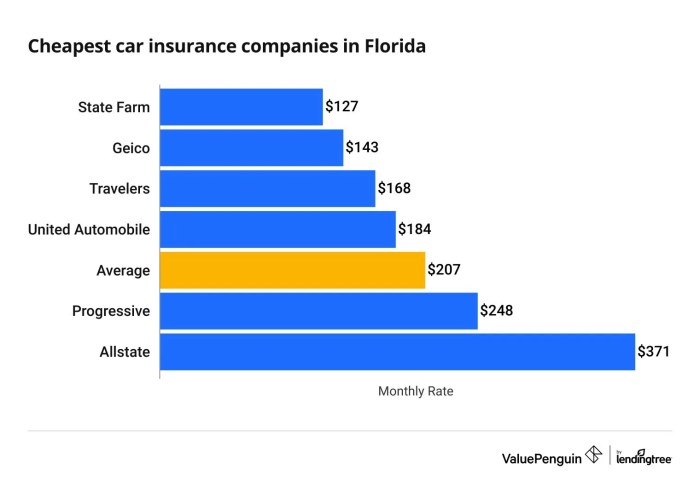Navigating the world of car insurance in Florida can feel like driving through a maze, especially when searching for affordable options. High costs, varying coverage levels, and a complex market can be daunting. This guide cuts through the confusion, offering a clear path to finding cheap car insurance in the Sunshine State, while ensuring you have the necessary protection.
We’ll explore the factors that influence your premiums, from your driving history and credit score to the type of vehicle you drive and where you live. We’ll also highlight reputable insurers offering competitive rates, detail various discounts and savings opportunities, and walk you through the process of obtaining quotes and filing claims. By the end, you’ll be equipped to make informed decisions and secure the best car insurance coverage at a price that fits your budget.
Understanding Florida’s Car Insurance Market
Navigating the Florida car insurance market can be complex due to several interacting factors. Understanding these factors is crucial for securing affordable and adequate coverage. This section will explore the key elements influencing insurance costs, the various coverage types available, and the differences between minimum requirements and recommended protection levels.
Florida’s car insurance costs are influenced by a variety of factors. These include the driver’s age and driving history (accidents, tickets, etc.), the type and value of the vehicle, the location of the driver’s residence (higher crime rates and accident frequency in certain areas can lead to higher premiums), and the amount and type of coverage selected. Insurance companies also consider credit scores, which in Florida are a significant factor in determining premiums. Furthermore, the type of vehicle plays a role; sports cars or high-performance vehicles often command higher premiums due to their increased risk of accidents and higher repair costs.
Types of Car Insurance Coverage in Florida
Florida offers several types of car insurance coverage. These are generally categorized as mandatory and optional coverages. Mandatory coverage includes Personal Injury Protection (PIP) and Property Damage Liability (PDL). PIP covers medical bills and lost wages for you and your passengers, regardless of fault. PDL covers the cost of repairing or replacing someone else’s vehicle if you cause an accident. Optional coverages include Collision, Comprehensive, Uninsured/Underinsured Motorist (UM/UIM) protection, and Medical Payments (MedPay). Collision covers damage to your vehicle caused by an accident, regardless of fault. Comprehensive covers damage to your vehicle caused by events other than collisions, such as theft, vandalism, or weather damage. UM/UIM protection covers your losses if you’re injured by an uninsured or underinsured driver. MedPay covers medical expenses for you and your passengers, regardless of fault, but typically has lower limits than PIP.
Minimum Coverage Requirements vs. Recommended Coverage Levels
Florida mandates minimum coverage levels of $10,000 in PIP and $10,000 in PDL. However, these minimums are often insufficient to cover significant medical expenses or property damage in the event of a serious accident. Many financial advisors recommend higher coverage limits, such as $100,000 or more in bodily injury liability and property damage liability, along with higher limits for UM/UIM coverage. This additional coverage offers greater financial protection in the event of a significant accident.
Examples of Situations Where Higher Coverage Limits Would Be Beneficial
Consider a scenario where you cause an accident resulting in serious injuries to another person. If your PDL coverage is only the minimum $10,000, and the medical bills exceed that amount, you could be held personally liable for the difference. This could lead to significant financial hardship, including potential lawsuits and the loss of personal assets. Similarly, if you are involved in an accident with an uninsured driver, UM/UIM coverage above the minimum would protect you from substantial out-of-pocket medical expenses. In another example, a collision involving a newer, high-value vehicle could easily result in repair costs exceeding the minimum property damage coverage. Higher coverage limits provide a financial safety net in these and similar situations.
Discounts and Savings Opportunities

Finding affordable car insurance in Florida is achievable, especially when you understand and leverage the numerous discounts available. Many insurers offer a variety of ways to lower your premiums, significantly impacting your overall cost. Taking advantage of these discounts can save you hundreds of dollars annually.
Common Car Insurance Discounts in Florida
Several common discounts are widely offered by Florida car insurance providers. These discounts can substantially reduce your premium, making insurance more accessible. Understanding these options and how to qualify is key to saving money.
- Good Driver Discount: This is perhaps the most common discount, rewarding drivers with clean driving records. Typically, drivers with no accidents or moving violations within a specified period (usually three to five years) qualify for a significant reduction in their premiums. The exact percentage varies by insurer.
- Safe Driver Discount/Telematics Programs: Many insurers offer discounts based on your driving behavior. These programs use telematics devices or smartphone apps to monitor your driving habits, rewarding safer driving with lower rates. Factors like speed, braking, and mileage are often considered.
- Bundling Discounts: Combining your car insurance with other types of insurance, such as homeowners or renters insurance, often results in a substantial discount. Insurers incentivize bundling policies as it simplifies their administration and reduces risk.
- Vehicle Safety Features Discount: Cars equipped with advanced safety features like anti-theft devices, airbags, anti-lock brakes, and electronic stability control often qualify for discounts. These features demonstrably reduce the risk of accidents and claims.
- Good Student Discount: Students who maintain a certain grade point average (GPA) may qualify for a discount. This reflects the lower risk associated with responsible and focused students.
- Multi-Car Discount: Insuring multiple vehicles under the same policy with the same insurer usually leads to a discount. This reflects the reduced administrative costs and potentially lower risk for the insurer.
- Senior Citizen Discount: Some insurers offer discounts to drivers over a certain age (typically 55 or 65), reflecting statistically lower accident rates in this demographic.
- Military Discount: Active-duty military personnel and veterans may be eligible for discounts, demonstrating appreciation for their service.
Obtaining Car Insurance Discounts
Securing these discounts involves a straightforward process. Providing accurate and complete information to your insurer is crucial for eligibility.
- Review your driving record: Assess your driving history for accidents, tickets, and violations. A clean record significantly increases your chances of qualifying for good driver discounts.
- Contact your insurer: Inquire about all available discounts. Don’t assume you know what’s offered; insurers often have promotions and specialized programs.
- Provide necessary documentation: Be prepared to provide proof of eligibility for any discounts you are claiming. This might include your driver’s license, student ID, military ID, or proof of homeownership.
- Consider telematics programs: If your insurer offers a telematics program, enroll to potentially earn a discount based on your driving behavior. This often involves installing an app or device in your car.
- Bundle your policies: If you have other insurance needs, explore bundling them with your car insurance for potential savings.
- Compare quotes: Obtain quotes from multiple insurers to compare prices and discounts. This ensures you’re getting the best possible rate.
Examples of Discount Savings
For example, a good driver discount could reduce your premium by 10-20%, while bundling your auto and homeowners insurance could save you an additional 15-25%. A safe driver discount from a telematics program could provide a 5-15% reduction based on your driving score. These discounts, when combined, can result in significant savings. A driver with a clean record, who bundles policies, and participates in a telematics program could potentially save hundreds of dollars annually. Let’s say your initial premium was $1200. A 20% good driver discount would save you $240. Adding a 15% bundling discount ($180) and a 10% telematics discount ($120) would result in a total annual savings of $540.
Illustrative Examples

Understanding the complexities of Florida’s car insurance market can be challenging, but real-world examples can clarify how different factors influence premiums. These examples illustrate how various scenarios can impact your insurance costs and how you might find affordable coverage.
A Young Driver with a Poor Driving Record Securing Affordable Insurance
A 20-year-old driver, Sarah, with two speeding tickets and a minor accident on her record, might find affordable insurance by taking proactive steps. She could enroll in a defensive driving course to reduce points on her license, which some insurers offer discounts for. Additionally, she could opt for a less powerful, older vehicle, significantly lowering her premium. Choosing a higher deductible and maintaining a good payment history will also demonstrate financial responsibility, improving her chances of obtaining a more favorable rate. Finally, comparing quotes from multiple insurers is crucial to finding the most competitive price. By implementing these strategies, Sarah can mitigate the high-risk profile associated with her age and driving history.
Vehicle Profile and its Impact on Insurance Costs
Consider a 2015 Honda Civic, a popular and relatively inexpensive vehicle to insure. Compared to a high-performance sports car like a 2023 Porsche 911, the Honda Civic’s lower repair costs and reduced risk of theft translate to significantly lower insurance premiums. The Porsche’s higher value, potential for more severe accidents due to its performance capabilities, and higher repair costs contribute to a substantially higher insurance premium. The year of the vehicle also plays a significant role; a newer car, even a less expensive model, might have higher premiums due to its value and advanced safety features (which may also result in higher repair costs). Older cars, while potentially cheaper to insure, might lack modern safety features, leading to higher premiums in some cases.
Bundling Home and Auto Insurance for Cost Savings
John and Mary own a home and two vehicles. By bundling their home and auto insurance with the same provider, they receive a significant discount, often around 10-15%, compared to purchasing separate policies. This discount reflects the insurer’s reduced administrative costs and the increased likelihood of retaining both policies. The specific savings will depend on the insurer and the individual risk profiles of the home and vehicles. For example, a larger, more valuable home might offset the savings from bundling less expensive vehicles.
Impact of Different Coverage Levels on Premiums
Imagine a bar graph. The horizontal axis represents different coverage levels: Liability Only (lowest coverage), Liability with Collision and Comprehensive, and Full Coverage (highest coverage). The vertical axis represents the premium cost. The bar representing Liability Only is the shortest, showing the lowest premium. The bar for Liability with Collision and Comprehensive is taller, reflecting a higher premium due to the added coverage. The tallest bar, representing Full Coverage, demonstrates the highest premium, as it provides the most extensive protection. This visual representation clearly illustrates the direct correlation between the extent of coverage and the associated premium cost. The specific amounts will vary greatly based on individual factors and location.
Final Summary

Securing cheap car insurance in Florida doesn’t have to be a stressful experience. By understanding the factors that influence premiums, comparing different insurers, and actively seeking discounts, you can significantly reduce your costs without compromising essential coverage. Remember to carefully review your policy and understand your coverage limits to ensure you’re adequately protected on Florida’s roads. Armed with the knowledge from this guide, you can confidently navigate the insurance market and find the perfect balance between affordability and comprehensive protection.
Clarifying Questions
What is the minimum car insurance coverage required in Florida?
Florida requires minimum coverage of $10,000 for bodily injury liability per person, $20,000 per accident, and $10,000 for property damage liability.
Can I get car insurance without a driver’s license?
No, you generally need a valid driver’s license to obtain car insurance in Florida.
How does my credit score affect my car insurance rates?
In Florida, insurers can consider your credit score when determining your rates. A good credit score typically leads to lower premiums.
What if I’m a new driver in Florida? How can I find affordable insurance?
New drivers often face higher premiums. Consider taking a defensive driving course to qualify for discounts and shop around for quotes from multiple insurers.